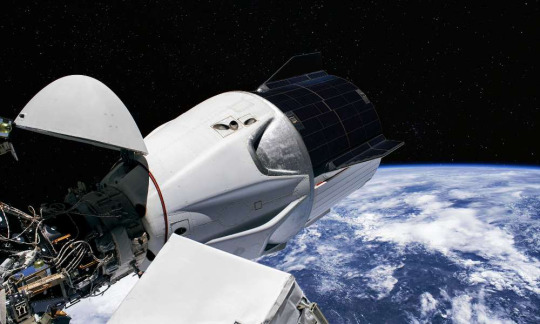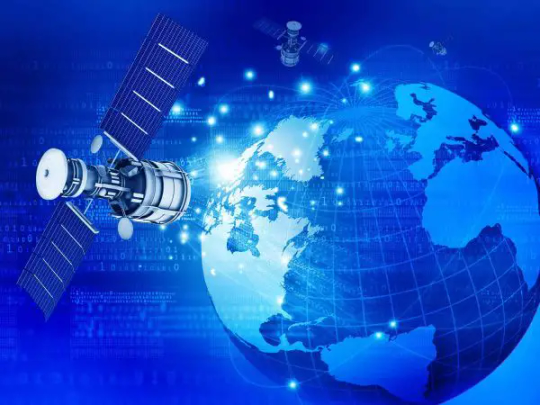#SatelliteInternet
Explore tagged Tumblr posts
Text
#Starlink#ElonMusk#SatelliteInternet#Jordan#MiddleEastTech#SpaceX#LEOSatellites#DigitalConnectivity#TechNews#ProjectKuiper#GlobalInternet
0 notes
Text
Starlink, SpaceX’s ambitious satellite internet project, aims to revolutionize global connectivity by deploying thousands of low-Earth orbit (LEO) satellites. While this project has made significant strides in providing internet access to remote and underserved areas, it also comes with a complex set of risks. Managing these risks effectively is crucial for Starlink’s long-term success.
From satellite deployment and operational hazards to regulatory challenges and cybersecurity threats, the Starlink project must navigate a vast array of risks to maintain its ambitious expansion.
#Starlink#SpaceX#RiskManagement#ProjectManagement#SatelliteInternet#Aerospace#CyberSecurity#SpaceDebris#RegulatoryCompliance#TechInnovation#AIinSpace#AgileDevelopment#SpaceExploration#BusinessStrategy#GlobalConnectivity
0 notes
Text

Starlink: Musk’s Internet Revolution Unveiled
Starlink is a group of satellites made by SpaceX, a company started by Elon Musk. The aim of this project is to make the internet faster in areas where it's not good, especially far away places. Starlink will send lots of small satellites into space that orbit close to Earth. These satellites will work together to make sure people can get good internet almost everywhere, even in places that are hard to reach.
➥ Background and Rationale ➲ Global Internet Connectivity Issues Access to the internet is crucial for modern life, but many parts of the world are still not connected or have poor connections. Traditional internet infrastructure like fiber-optic cables and cell towers often can't reach rural or isolated areas because they are too expensive and difficult to set up. This gap in digital access worsens inequalities, making it harder for people to get education, healthcare, and job opportunities.
➲ Technological Innovations SpaceX’s Starlink uses new satellite technology to solve these problems. In the past, satellite internet was slow and had delays because signals had to travel very far. Starlink's plan is to put satellites in Low Earth Orbit (LEO), which is much closer to Earth, making the internet faster and more responsive.
➥ Technical Specifications ➲ Satellites Starlink satellites are small and flat, each weighing about 260 kg. They have several high-speed antennas and one solar panel. The satellites work in the Ku-band and Ka-band frequencies, offering various services. Key features include: Low Latency: Placed at heights between 340 km and 1,200 km, the closeness to Earth reduces signal travel time, achieving latencies as low as 20 ms.
Read in detail: https://www.knowledgewale.com/2024/05/starlink-musks-internet-revolution.html
#starlink#elonmusk#spacex#internetrevolution#satelliteinternet#globalconnectivity#lowlatency#highspeedinternet#broadband#ruralinternet#5ginternet#digitaldivide#starlinksatellites#internetforall#techinnovation#futureofinternet#elonmuskstarlink#aerospace#spacexstarlink#satellitenetwork#starlinkcoverage
0 notes
Text
Tech Mix Key To Saving Ailing Federal Broadband Program: RPT

A new report highlights the need for a technology-neutral broadband approach to bridge the digital divide. https://jpmellojr.blogspot.com/2025/01/tech-mix-key-to-saving-ailing-federal.html
0 notes
Text
Elon Musk Addresses Starlink Device Use Allegations in Manipur
https://enterprisewired.com/wp-content/uploads/2024/12/1-Elon-Musk-Addresses-Starlink-Device-Use-Allegations-in-Manipur-Source-freepressjournal.in_.jpg
Source: freepressjournal.in
Share Post:
LinkedIn
Twitter
Facebook
Reddit
Pinterest
Starlink Beams Allegedly Linked to Conflict
Elon Musk, the founder of SpaceX, recently clarified that Starlink satellite beams have been “turned off over India.” His statement came in response to allegations that a Starlink device was being used in the conflict-hit region of Manipur. The controversy arose after Indian security forces seized internet devices, along with arms and ammunition, during a raid in the Keirao Khunou area of Imphal East district.
Images shared by the Spear Corps of the Indian Army on social media depicted the seized items, sparking public interest when observers noted that one of the devices bore the Starlink logo. This discovery fueled speculations about the potential role of satellite internet in escalating tensions in the region.
Details of the Seizure in Manipur
On December 16, the Indian Army’s Spear Corps released a statement detailing the outcomes of coordinated raids conducted in Manipur. The joint operations involved troops from the Indian Army, Assam Rifles, and Manipur Police, targeting both hill and valley regions in the districts of Churachandpur, Chandel, Imphal East, and Kangpokpi. During these operations, it was confirmed that Starlink satellite beams were inactive over the region, ensuring no external technological interference.
The operation led to the recovery of an extensive cache of weapons and equipment, including 29 firearms such as sniper rifles, automatic weapons, pistols, country-made mortars, and single-barrel rifles. Additionally, grenades, ammunition, and other war-like materials were confiscated. The forces emphasized the significance of the raids in disrupting unlawful activities in the troubled region.
Musk’s Statement on Starlink’s Involvement
Elon Musk’s comments on social media aimed to address concerns about Starlink’s potential misuse. By asserting that Starlink satellite beams are inactive over India, Musk sought to dispel allegations of the technology’s involvement in the ongoing violence in Manipur. While his statement was brief, it highlighted the measures SpaceX takes to control the deployment and usage of its satellite internet services in sensitive regions.
This clarification comes amid heightened scrutiny of technology’s role in conflict zones. Social media platforms and communication technologies are often debated for their impact on security and their potential misuse. The revelations about the seized Starlink device, coupled with Musk’s response, underscore the growing complexities surrounding technology’s influence in global and local conflicts.
#Starlink#StarlinkBeams#SpaceX#SatelliteInternet#StarlinkSatellite#SpaceTechnology#GlobalInternet#StarlinkInternet
0 notes
Link
Elon Musk يقدم Tesla Model Pi: هاتف ذكي يعيد
#pixelarab#SatelliteInternet#TechInnovation#ElonMusk#FutureTech#Smartphones#SolarCharging#بيكسل_عرب#TeslaModelPi#TeslaPhone
0 notes
Text
Starlink’s direct-to-cell satellite service is the first to receive FCC approval
> The T-Mobile license is the first collaboration between a satellite operator and wireless carrier to be approved by the FCC to provide supplemental cell coverage from space.

#Starlink#TMobile#FCCApproval#SatelliteService#DirectToCell#SpaceConnectivity#MobileCoverage#Telecommunications#Innovation#DeadZones#SpaceX#WirelessCarrier#EmergencyCommunications#SatelliteInternet#TechNews
0 notes
Text
With OneWeb’s Microsatellites, SpaceX Creates History With Achieving 100 Launch Milestone in 2024

SpaceX Launches OneWeb’s Microsatellites — Achieves 100th Launch Milestone for 2024
📖To read more visit here🌐🔗: https://onewebinc.com/news/spacex-launches-oneweb-microsatellites-and-completes-100-launch-milestone-in-2024/
#spacex#oneweb#satellitelaunch#microsatellites#spacemilestone#aerospaceinnovation#satelliteinternet#spaceexploration#launchsuccess#futureofspace
0 notes
Text
The Future of Connectivity: Satellite Internet Technology
As we navigate an increasingly connected world, satellite internet technology is paving the way for seamless communication, even in the most remote locations. This innovative solution allows users to access high-speed internet where traditional options fall short, enabling everything from casual browsing to professional video conferencing.
Imagine being able to work from a mountain cabin, enjoy a video call with family while camping, or stream your favorite shows from anywhere. With satellite internet, these possibilities are becoming a reality, breaking down barriers and expanding our horizons.
Read more: Skype VoIP via satellite internet in remote locations.
#SatelliteInternet#VoIP#Connectivity#TechInnovation#RemoteWork#DigitalNomad#FutureOfInternet#StayConnected
0 notes
Text
Rocket Reuse Triumph: SpaceX Ignites a New Space Age
Rocket Reuse Triumph: SpaceX Targets New Heights In a testament to the company unwavering commitment to rocket reusability, the aerospace giant is poised to outdo its own record. The stage is set for the launch of a Falcon 9 rocket, slated to carry 23 Starlink internet satellites into orbit. The anticipated liftoff from Florida’s Cape Canaveral Space Force Station promises to be a spectacle,…

View On WordPress
1 note
·
View note
Text
🌐 Bridging the Digital Divide with Satellite Internet 🚀 Discover how cutting-edge technology is connecting the world beyond city limits. Read more at
0 notes
Text
#ProjectKuiper#AmazonSpace#SatelliteInternet#StarlinkRival#SpaceX#KuiperSatellites#GlobalInternet#HighSpeedBroadband#SatelliteNetwork#TechInnovation#SpaceExploration#Aerospace#SpaceIndustry#InternetForAll#TechCompetition#ULA#LockheedMartin#BlueOrigin
0 notes
Text
Starlink: SpaceX's Game-Changing Contribution To Global Connectivity - Streetcurrencies

In a world increasingly reliant on digital communication, access to high-speed internet has become a necessity for economic growth and development.👈
SpaceX, under the leadership of Elon Musk, is stepping up to address this global challenge with its groundbreaking project known as Starlink. In this blog, we'll explore how SpaceX's Starlink initiative is poised to revolutionize global connectivity and stimulate economic development, especially in underserved regions.
What Is SpaceX's Starlink Project?
Starlink is a project by SpaceX that aims to deploy a constellation of thousands of small satellites in low Earth orbit (LEO). These satellites work together to create a vast network capable of providing high-speed internet access to even the most remote and underserved areas on Earth.
Connecting The Unconnected: Bridging The Digital Divide
In many parts of the world, access to the internet is still a luxury, not a utility. The digital divide, the gap between those with reliable internet access and those without, is a significant barrier to economic development. Starlink seeks to bridge this divide by offering global internet coverage, including in areas where traditional internet infrastructure is challenging to deploy.
The Economic Impact Of Improved Connectivity
Education: In underserved regions, limited internet access can hinder educational opportunities. With Starlink's high-speed internet, students can access online resources, attend virtual classes, and access educational materials, leveling the playing field for quality education.
Healthcare: Telemedicine has become increasingly important, especially during the COVID-19 pandemic. With reliable internet access, remote healthcare consultations and access to medical information become accessible to more people, improving healthcare outcomes.
Agriculture: Farmers in rural areas can benefit from real-time weather data, market information, and agricultural best practices available online. Improved connectivity can lead to increased agricultural productivity and income.
Entrepreneurship: Access to a global market is essential for entrepreneurs and small businesses. With Starlink, individuals and small enterprises in remote areas can engage in e-commerce, expand their customer base, and foster economic growth locally.
Economic Diversification: Reliable internet access can attract businesses and investments to underserved regions, promoting economic diversification and reducing dependency on traditional industries.
Starlink's Global Impact
SpaceX has already made significant progress with its Starlink project, providing internet services to users in multiple countries through its beta program. As the constellation of satellites continues to expand, so will its global impact on connectivity and economic development.
In Conclusion
SpaceX's Starlink project is not just about providing internet access; it's about empowering people and communities worldwide. By bridging the digital divide and offering reliable, high-speed internet in underserved regions, Starlink has the potential to stimulate economic development, improve education, enhance healthcare, and drive innovation in areas that were once isolated from the digital world.
As Starlink continues to reach new horizons, the dream of global connectivity is becoming a reality, bringing us closer to a more inclusive and connected world.
#Starlink#SpaceX#GlobalConnectivity#SatelliteInternet#SpaceTechnology#InternetEverywhere#DigitalRevolution#SpaceInnovation#FutureConnectivity#HighSpeedInternet
0 notes
Text
Who are the billionaire contenders in India's satellite spectrum battle?

Several billionaires, including Elon Musk, Mukesh Ambani, and Jeff Bezos, are currently engaged in a fierce competition for control over satellite spectrum in India. This highly valuable resource can be utilized to provide various services, such as broadband internet, television, and mobile telephony.

The battle for spectrum dominance in India has intensified as more companies enter the fray. In February 2023, Elon Musk's SpaceX submitted an application to the Indian government seeking permission to launch an unprecedented constellation of 100,000 low-Earth orbit satellites. If approved, this ambitious project would grant SpaceX a significant advantage in the Indian market. Notably, other prominent contenders, such as Tata Group, Reliance Industries, and Amazon, have also filed spectrum applications in India. These companies recognize the immense potential for expansion within the Indian market and perceive satellite spectrum as a crucial pathway to achieve their goals. The contest for spectrum allocation in India is expected to be protracted and arduous. The Indian government has yet to disclose the quantity of spectrum to be auctioned, and the financial stakes remain uncertain. Nevertheless, it is evident that this struggle for spectrum control will test the mettle of these billionaire-backed companies. Key Players in the Battle for Spectrum in India: Elon Musk Through SpaceX, Elon Musk is vigorously vying for spectrum supremacy in India. SpaceX has applied to launch a staggering constellation of 100,000 low-Earth orbit satellites, constituting the largest such deployment in history. Should this plan materialize, SpaceX would secure a commanding presence in the Indian market. Mukesh Ambani Reliance Industries, headed by Mukesh Ambani, is another major contender in the race for spectrum dominance in India. The company has already launched the GSAT-15 satellite and intends to deploy further satellites in the future. Reliance aims to leverage spectrum resources to provide broadband internet and other services to Indian consumers. Jeff Bezos Amazon, led by Jeff Bezos, also seeks to establish a foothold in the Indian market through spectrum acquisition. Amazon has submitted an application to launch a constellation of 3,200 satellites. The company intends to employ spectrum to deliver broadband internet and other services to its Indian customer base. Tata Group The Tata Group is a significant player in the battle for spectrum in India. Having already launched the GSAT-19 satellite, the company plans to launch additional satellites to leverage spectrum for broadband internet and other services catering to Indian consumers. The outcome of the spectrum contest in India will likely have a profound impact on the country's telecommunications industry. Winning companies will be empowered to offer an expanded array of services, potentially at higher prices. Consequently, increased competition within the telecommunications sector may ultimately benefit consumers. However, this battle for spectrum allocation also presents some challenges. Higher spectrum prices may impede smaller companies from competing effectively. Moreover, the intensified utilization of airwaves could result in congestion, potentially compromising service quality for consumers. In summary, the battle for spectrum in India is a multifaceted issue with potential benefits and risks. Monitoring the unfolding competition and its long-term implications for the Indian telecommunications industry will be of great interest. Read the full article
#battleforspectruminindia#bhartiairtel#billionaire-backedcompaniesinindia#billionaires#broadbandinternet#broadbandinternetinindia#ElonMusk#elonmuskinindia#india#interestrates#mukeshambani#mukeshambaniinindia#relianceindustries#satelliteinternet#satelliteinternetinindia#satellitespectrum#satellitespectruminindia#spectrumauction#sunilmittal#sunilmittalinindia#t-series#tatagroup#telecommunicationindustryinindia#telecommunicationsindustry#UK#USeconomy#USA
0 notes
Text
Amazon's Rival to Starlink Takes Critical Step Toward Deployment

Amazon’s Kuiper low Earth orbit (LEO) satellite network passed a significant milestone when its two orbiting satellites were able to communicate with each other at high data transfer speeds using Optical Inter-Satellite Link (OISL) technology, the company revealed last week. https://jpmellojr.blogspot.com/2023/12/amazons-rival-to-starlink-takes.html
#Amazon#ProjectKuiper#satelliteinternet#OISL#meshnetwork#LEOsatellites#Starlink#JeffBezos#ElonMusk#SpaceX
0 notes
Video
youtube
Amazon Delays Kuiper Internet Satellite Launch Due to Bad Weather | Star...
#youtube#AmazonKuiper SatelliteInternet StarlinkRival KuiperLaunchDelay JanMediaTV TechNews SpaceInternet ElonMuskVsBezos AmazonSatellites LEOSatelli
0 notes